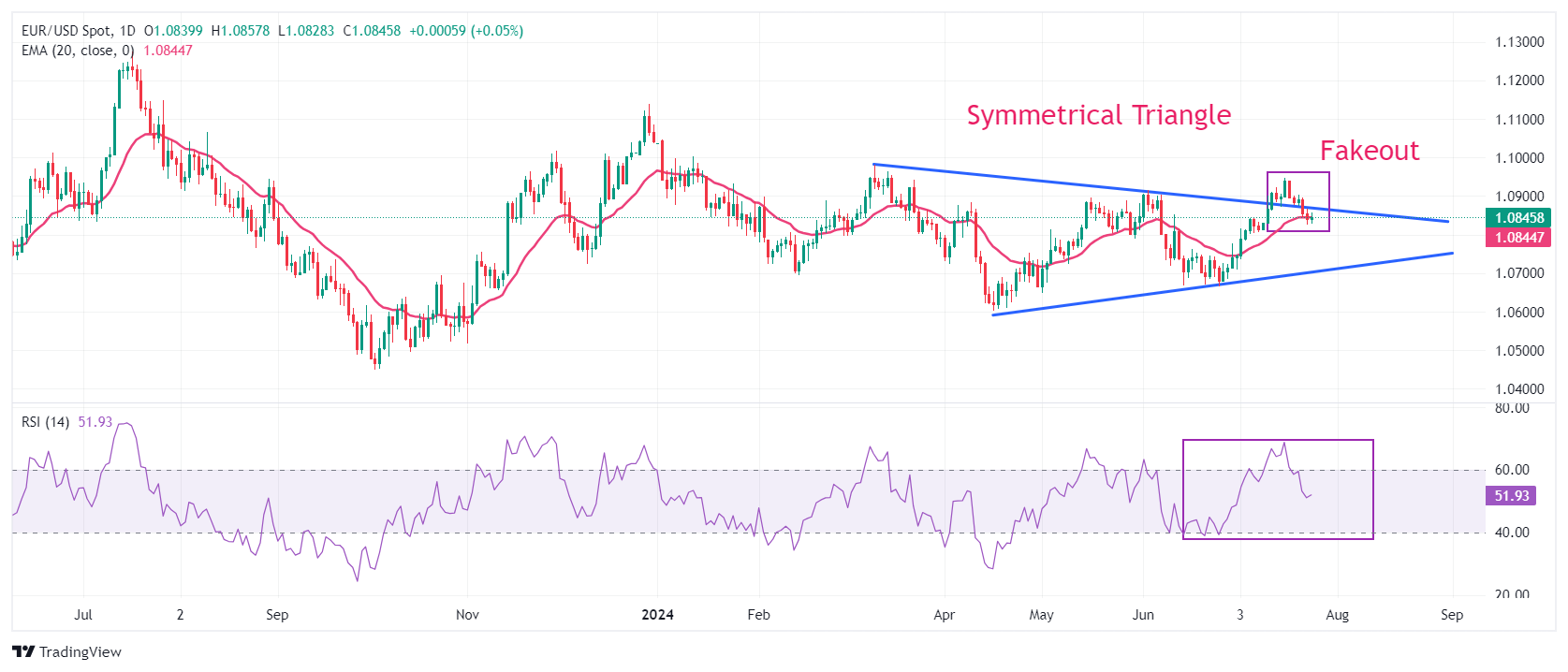EUR/USD Recovers As US Dollar Declines With Focus On US Q2 GDP
EUR/USD bounces back to near 1.0850 in Thursday’s European session. The major currency pair moves higher as the US Dollar (USD) exhibits a sluggish performance on the United States (US) Q2 flash Gross Domestic Product (GDP) day. The US Dollar Index (DXY), which tracks the Greenback’s value against six major currencies, hovers below the weekly high of 104.50.
The US Q2 GDP is estimated to have grown at a faster pace of 2.0% from the former release of 1.4% on an annualized basis, while the GDP Price Index, a key measure to gauge changes in the prices of goods and services produced, is seen decelerating to 2.6%. This would boost expectations of rate cuts by the Federal Reserve (Fed).
According to the CME FedWatch tool, 30-day Federal Fund futures pricing data shows that a rate cut in September appears certain. The data also indicate that the Fed will cut interest rates twice this year.
In addition to US Q2 GDP data, investors will also focus on the Durable Goods Orders for June, which are expected to have grown at a faster pace of 0.3% from May’s reading of 0.1%.
This week, the major trigger for the US Dollar will be the Personal Consumption Expenditures Price Index (PCE) data for June, which will be published on Friday. The core PCE inflation, the Fed's preferred inflation gauge, will indicate whether market expectations for rate cuts in September are appropriate.
The underlying inflation is estimated to have decelerated to 2.5% from May’s figure of 2.6%, with the monthly figure growing steadily by 0.1%. The scenario in which inflationary pressures decelerate in line with expectations or at a faster pace will be unfavorable for the US Dollar as it will boost rate cut expectations. On the contrary, steady or higher-than-expected inflation growth will force traders to pare Fed rate-cut bets for September.
Daily digest market movers: EUR/USD rises despite the Euro's outlook remains uncertain
- EUR/USD rebounds to near 1.0850 in Thursday’s European session. The major currency pair recovers despite the Euro's uncertain near-term outlook due to firm expectations of more rate cuts by the European Central Bank (ECB) and deepening concerns over German economic prospects.
- The ECB is expected to cut interest rates two more times this year as price pressures are expected to remain at their current levels for the entire year and will return to the bank’s target in 2025. Some ECB officials also see current market expectations for rate cuts as appropriate.
- Meanwhile, a sharp decline in Eurozone business activity, especially in the bloc’s largest nation, Germany, has boosted expectations of more interest rate cuts this year to prompt economic growth. German flash Composite Purchasing Managers Index (PMI) unexpectedly contracted in July. Hamburg Commercial Bank (HCOB) reported on Wednesday that preliminary German Composite PMI surprisingly declined to 48.7 in July, the lowest reading in four months. The economy skirted a recession last year but contracted by 0.3%.
- Poor German activity has also dampened its business sentiment index. German IFO Business Climate, an early indicator of current conditions and business expectations, surprisingly declined to 87 in July. Investors forecasted the sentiment data to have risen to 88.9 from June’s reading of 88.6. In the same period, the Expectations index unexpectedly dropped to 86.9 from the estimates of 89.0 and the former release of 88.8, downwardly revised from 89.0.
- The German government promises to provide tax relief to corporations and households in a move to boost overall consumption. The tax relief move announced by German Finance Minister Christian Lindner on Wednesday will pave the way for a 30-billion-euro reduction in the tax burden in 2025 and 2026, an effort to leave the economy with more funds for spending and investment.
Technical Analysis: EUR/USD holds key support of 1.0800
(Click on image to enlarge)
EUR/USD returns inside the Symmetrical Triangle formation on a daily timeframe after failing to hold the breakout. The major currency pair extends its downside below the 20-day Exponential Moving Average (EMA), which trades around 1.0840. The shared currency pair could slide further towards round-level supports near 1.0800 and 1.0700.
The 14-day Relative Strength Index (RSI) returns within the 40.00-60.00 range, suggesting the bullish momentum has faded.
On the upside, the round-level resistance at 1.0900 will be a key barrier for the Euro bulls.
More By This Author:
Gold Price Gains As Us Yields Slumps Amid Firm Fed Rate-Cut BetsUSD/JPY Slides Further To 156.00 On Firm BoJ Rate-hike Bets
WTI Plummets As Surprise PBoC Rate Cuts Raise Uncertainty Over China’s Economic Outlook
Disclaimer: Information on this article contains forward-looking statements that involve risks and uncertainties. Markets and instruments profiled on this page are for informational purposes ...
more



